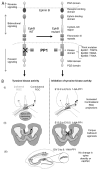To phosphorylate or not to phosphorylate: Selective alterations in tyrosine kinase-inhibited EphB mutant mice
- PMID: 24589619
- PMCID: PMC3974787
- DOI: 10.4161/cam.27478
To phosphorylate or not to phosphorylate: Selective alterations in tyrosine kinase-inhibited EphB mutant mice
Abstract
EphB tyrosine kinase receptors have been implicated in multiple developmental processes; however, the signaling mechanism underlying these events remains unclear. Through a triple knock-in mouse line for three neurally expressed EphBs, Sokis et al. demonstrated that EphB tyrosine kinase activity is required for axon guidance but does not influence synapse formation. This short communication highlights their study and appealing molecular approach that elucidated the functions of EphB tyrosine kinase during developmental events.
Keywords: Eph B; PP1 analogue; bidirectional signaling; ephrin; tyrosine kinase.
Figures

Comment on
-
A chemical genetic approach reveals distinct EphB signaling mechanisms during brain development.Nat Neurosci. 2012 Dec;15(12):1645-54. doi: 10.1038/nn.3249. Epub 2012 Nov 11. Nat Neurosci. 2012. PMID: 23143520 Free PMC article.
References
-
- Gale NW, Holland SJ, Valenzuela DM, Flenniken A, Pan L, Ryan TE, Henkemeyer M, Strebhardt K, Hirai H, Wilkinson DG, et al. Eph receptors and ligands comprise two major specificity subclasses and are reciprocally compartmentalized during embryogenesis. Neuron. 1996;17:9–19. doi: 10.1016/S0896-6273(00)80276-7. - DOI - PubMed
Publication types
MeSH terms
Substances
LinkOut - more resources
Full Text Sources
Other Literature Sources
Miscellaneous
